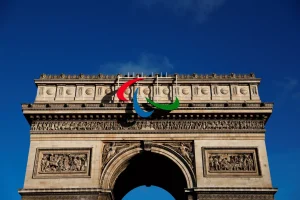Some 200 years ago, Jean-François Champollion revealed the secrets of hieroglyphs, enabling us to lift the veil on Egyptian life and society. Now, your Vélib’ can become your very own Rosetta stone, helping you to decode the clues hidden in the buildings and monuments where that ancient, timeless, unforgettable civilization that is Egypt lies hidden in the heart of the French capital.

Starting point: station n°2017 Caire – Dussoubs
Finishing point: station n°7109 Place Joffre – Frédéric le Play
Itinerary distance: approx. 9.3 km
Journey time: approx. 2 hours – this city-based itinerary uses shared bus/taxi/cycle lanes. For a more pleasant experience, avoid rush hour!
Place du Caire – a district with something of an Egyptian vibe

©Guilhem Vellut on Flickr, Façade of place du Caire
The first stage in our ‘cycle-powered cruise’ is the iconic Sentier district, built following Napoleon’s Egyptian campaign. Where now we have Rue du Caire, Rue d’Aboukir and Rue du Nil, once stood the convent of Filles-Dieu, originally founded to house ex-prostitutes. It’s out with the statues of saints and crucifixes, which have given way to a completely different decor! If you look closely at the façade of 2 Place du Caire, you’ll see the face of Egyptian goddess Hathor no fewer than 3 times! Sometimes shown with a cow’s head or with a headdress of cow horns, between which is placed a sun disk, she was mostly worshipped as a goddess of music, dance, joy and Love. An accompanying frieze features hieroglyphs, but there’s little point trying to work out what they mean – they were placed at random as they were carved after Napoleon’s return from the Egyptian campaign but before Champollion was able to crack their code!
Go down Rue du Caire then take Rue Dussoubs on your right. Then take a left onto Rue Greneta until you reach Boulevard Sébastopol. Turn right and continue to Place du Châtelet.
An oasis in the heart of Paris – the Palm Fountain (Fontaine du Palmier) in Châtelet

©Selbymay on Wikicommons, Fontaine du Châtelet
Four sphinxes stand guard around this magnificent fountain. However, they’re not watching over a hidden entrance to the underworld but rather a free source of clean drinking water which was created by Napoleon Bonaparte! Caught up in the craze for all things Egyptian, Napoleon requested this fountain be built in 1806. If you look closely at the slim column topped by a gilded bronze statue of Victory and palm leaves, you’ll spot the names of various Napoleonic conquests carved into the monument (we’re talking about places, rather than romantic conquests here, to be clear).
Take the cycle path up Rue de Rivoli as far as the Louvre.
« Walk like an Egyptian » at the Louvre

©Guillaume Meurice on Unsplash, Pyramide du Louvre
The famous glass pyramid located in the Cour Napoléon has become emblematic of Paris. It was originally built to commemorate the bicentenary of the French Revolution as part of the ‘Grand Louvre’ project. François Mitterrand commissioned Chinese-American architect I. M. Pei to create the design, which was based on the proportions of the famous Great Pyramid of Giza. Urban legend claims that the structure comprises exactly 666 panes, a reference to the so-called ‘number of the beast’. Why not enjoy the Aile Lemercier wing of the Louvre on the western side of the Cour carrée: Napoleon (yes, him again!) asked for various patterns and symbols from the times of antiquity to be added to the façade in 1806. Try to find Moses with the ten commandments, Isis with a falcon and Cleopatra.
Back onto Rue de Rivoli as far as the Place de la Concorde.
The Luxor obelisk mission: place de la Concorde

©dm1795 on Flickr, Obélisque, place de la Concorde
It was a huge logistical task to move this obelisk to Paris from its original location in front of the Luxor temple! Chosen in 1830 by Jean-François Champollion, this ‘little’ gift from the viceroy of Egypt, Muhammad Ali Pasha, had to be transported by a ship specially designed for the purpose, given that it weighed 230 tonnes and was 23 metres long. The ruler actually gave two obelisks to the French, but François Mitterrand finally formally renounced ownership of the second one in 1981. The obelisk was positioned on a pedestal designed for a statue of Louis XVI, who by this time wasn’t really in vogue. A change was definitely in order!
Cross over the Nile, sorry, we mean the Seine, via the Pont de la Concorde then continue onto Quai Anatole France on your left. Turn right down Rue de Solférino then take a left onto Boulevard Saint-Germain. Take the first street on your right (Rue de Bellechasse) and continue until you reach Rue Vaneau. Keep going along this street until you come to the Rue de Sèvres and turn right.
Peasant or lover at the fontaine du Fellah?

©Siren-Com on Wikicommons, Fontaine du Fellah
A ‘fellah’ is an Arab ‘peasant’. However, this statue is actually a depiction of Antinous, the Emperor Hadrian’s favourite and lover. He died in mysterious circumstances at the age of 20, by drowning in the Nile. No-one knows if the young man died accidentally or as a ‘voluntary’ human sacrifice. Does this face seem somehow familiar? You’ve a keen eye! Antinous appears in many works of art and is to this day one of the most famous faces from the period of Antiquity.
Do you see the Imperial eagle on this arch, built in the style of an Egyptian temple? The eagle replaced the winged sun symbol beloved of the Egyptians, as it would have been more familiar to everyone during the time of the Napoleonic Empire and its famous military campaigns.
Go along Rue de Sèvres towards ‘Sèvres-Babylone’ metro station and turn left onto Rue du Bac, then turn left again onto Rue de Babylone, which turns into Rue d’Estrées. On reaching Avenue Duquesne, turn right onto the avenue. When you reach ‘Ecole Militaire’ metro station, turn left onto Place Joffre then take a right onto Avenue Frédéric le Play. Turn left down Rue de Belgrade which becomes Avenue Charles Risler, running through the Champs de Mars. Watch out – there are a lot of pedestrians around.
The Monument to the Rights of Man (Monument des Droits de l’Homme)

©Mischmische on Wikicommons, Monument des droits de l’Homme
The last stage in our Egyptian-inspired itinerary is the monument to the Rights of Man and to the Citizen, which was directly inspired by Egyptian mastabas, tombs built for royalty and high officials of the first two dynasties. In amidst the symbols and writing covering the obelisks you can also read the famous 1789 Declaration of the Rights of Man and of the Citizen. If you look closely at the different façades of the monument, you’ll find numerous nods to the world of freemasonry (ouroboros, sun dials, triangles etc).
Leave your Vélib’ at station n°7109 Place Joffre – Frédéric Le Play. If you have some time to spare, go back to the Louvre and visit the exhibition ‘Pharaon des Deux Terres – L’épopée africaine des rois de Napata’ (Pharaoh of the Two Lands – the African story of the Kings of Napata).

